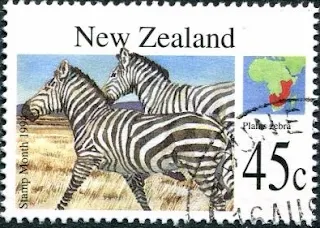It seemed strange that NZ Post would go off and feature animals from other countries like in this issue but there is a good explanation. Wild animals have always been a source of fascination amongst children and it was this subject that was selected for the 1994 stamp issue that coincided with Stamp Month - a month-long promotion each year that promotes stamp collecting among children,
The ten animals were carefully selected as being ones that children would recognise most readily. Most of them can also be found in zoos in New Zealand. Each stamp also presents a mini-lesson in geography, with a small map showing where each animal comes from.
The Polar bear, Siberian tiger and Giant panda are found in three of the most forbidding regions on earth. Each has evolved to cope with harsh climatic extremes. The mountains of central and western China are the panda's only known habitat. Also rare is the magnificent Siberian tiger, the largest member of the cat family.
Africa means wild animals to many - the animals chosen from the jungles and open, grassy plains were the giraffe, African lion and African elephant along with the Plains zebra, the White rhinoceros and the hippopotamus. The spider monkey is found in the forests between Mexico and the southern part of the Amazon basin.
The ten animals were carefully selected as being ones that children would recognise most readily. Most of them can also be found in zoos in New Zealand. Each stamp also presents a mini-lesson in geography, with a small map showing where each animal comes from.
The Polar bear, Siberian tiger and Giant panda are found in three of the most forbidding regions on earth. Each has evolved to cope with harsh climatic extremes. The mountains of central and western China are the panda's only known habitat. Also rare is the magnificent Siberian tiger, the largest member of the cat family.
Africa means wild animals to many - the animals chosen from the jungles and open, grassy plains were the giraffe, African lion and African elephant along with the Plains zebra, the White rhinoceros and the hippopotamus. The spider monkey is found in the forests between Mexico and the southern part of the Amazon basin.
The Stamps.
We had trouble finding good single mint stamps without cutting them out of a full strip so we have decided to feature something a bit different for this blog. Below the stamps are used, two examples of each with all the stamps on the right-hand side being from the first day of issue.
45c - Giraffe / Africa (used). 45c - Giraffe / Africa (FDC used).
45c - Siberian Tiger / Siberia (used). 45c - Siberian Tiger / Siberia (FDC used).
45c - Hippopotamus / Africa (used). 45c - Hippopotamus / Africa (FDC used).
45c - Spider Monkey / Central America (used). 45c - Spider Monkey / Central America (FDC used).
45c - Giant Panda Bear / Central and Western China (used). 45c - Giant Panda Bear / Central and Western China (FDC used).
45c - Polar Bear / Arctic (used). 45c - Polar Bear / Arctic (FDC used).
45c - African Elephant / Africa (used). 45c - African Elephant / Africa (FDC used).
45c - White Rhinoceros / Africa (used). 45c - White Rhinoceros / Africa (FDC used).
45c - African Lion / Africa (used). 45c - African Lion / Africa (FDC used).
45c - Plains Zebra / Africa (used). 45c - Plains Zebra / Africa (FDC used).
Full Strips of 10 Stamps.
The stamps were produced in strips of ten with ten such strips (rows) to a full sheet of stamps. Each row of stamps on each sheet had the stamps in a different order, so no one stamp design appeared twice in the same position on any row of stamps. Notice this in the two strips below which are both in a different order to the strip above and in our header.
First Day Cover.
First Day Cover.
1994 Philakorea World Stamp Exhibition.

$2.70 - Wild Animals Exhibition Miniature Sheet.
A miniature sheet, incorporating six stamps from the 1994 Wild Animals stamp issue, was produced to celebrate the 1994 Philakorea World Stamp Exhibition held 16-25 August 1994 in Seoul, a city that was celebrating its 600th anniversary as Korea's capital.

$2.70 - Wild Animals Exhibition Miniature Sheet.
A miniature sheet, incorporating six stamps from the 1994 Wild Animals stamp issue, was produced to celebrate the 1994 Philakorea World Stamp Exhibition held 16-25 August 1994 in Seoul, a city that was celebrating its 600th anniversary as Korea's capital.
Technical information.
Date of issue: 20 July 1994.
Designer: Denise Durkin, Wellington, NZ.
Printer: Leigh-Mardon, Australia.
Stamp size: 40mm x 28mm; Miniature Sheet 125mm x 100mm.
Sheet size: 100 stamps per sheet; Miniature Sheet of six stamps.
Process: Lithography.
Perforation gauge: 14 x 14.5.
Paper type: Coated Papers, red phosphor coated, unwatermarked.
Period of sale: Theses stamps remained on sale until 20 July 1995.
Some of the images in this post were used with permission from the illustrated catalogue of StampsNZ.
You can visit their website and On-line Catalogue at, http://stampsnz.com/
You can visit their website and On-line Catalogue at, http://stampsnz.com/

























We appreciate your engagement with our content. To ensure a respectful and constructive community, please take note of the following:
- No Spam, Please: We do not tolerate spammy or promotional comments. Any such comments will be promptly removed.
- Moderation in Place: All comments are moderated to maintain a positive and inclusive environment. Please be patient, as it may take a little time for your comment to appear.
- Sign In with Google: To comment, please sign in using your Google account. This helps us maintain the integrity of our community and allows for better interaction.